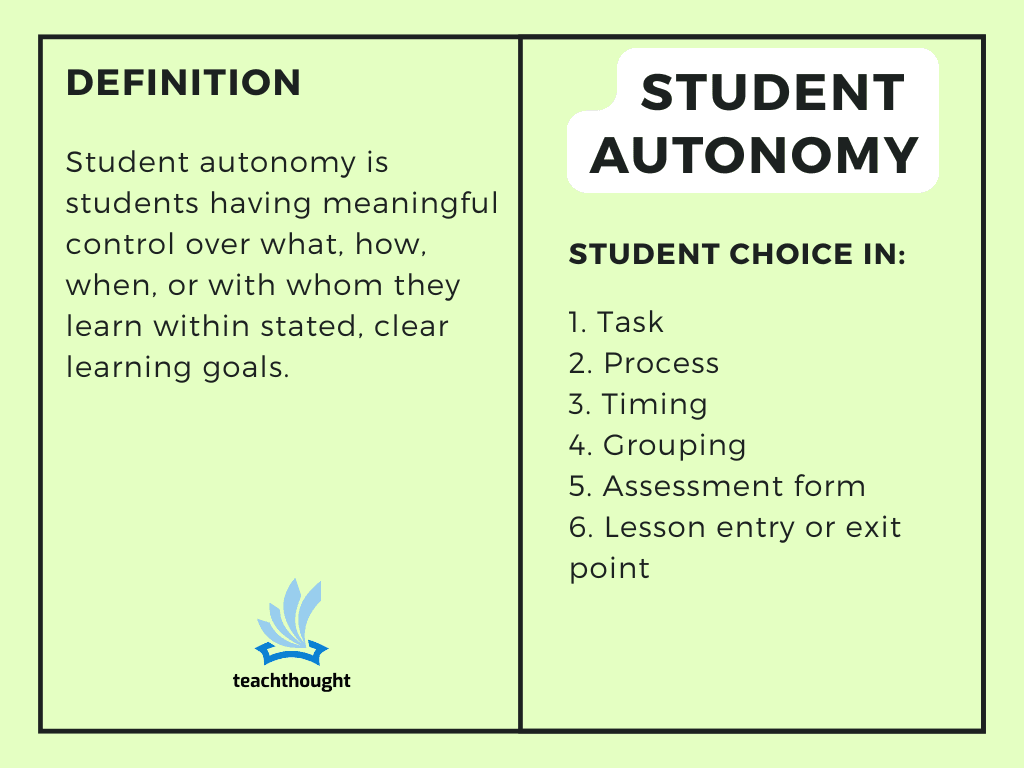Definition: Student autonomy is students having more meaningful control over what, how, when, or with whom they learn.
Student Autonomy Definition
Student autonomy is students having meaningful control over parts of their learning within clear goals — what to work on, how to show learning, when to complete tasks, or whom to work with.
Edward L. Deci & Richard M. Ryan, Intrinsic Motivation and Self-Determination in Human Behavior (1985).
Student Autonomy Meaning
Picture a lesson. Most decisions fall to the teacher: which text to read, which problem to start with, how long the work should take, whether to allow partners.
Autonomy asks you to study those decisions one by one:
- Which could students own without losing focus of the stated objective (ideally written in student-friendly language)?
- What would happen if students had a chance to choose which text to read first?
- What would happen if students had a chance to choose which problem to try first?
- What would happen if students had a chance to choose whether to work alone, in pairs, or in a group?
Deci and Ryan’s Self-Determination Theory shows that autonomy is a basic human need. Classrooms where students make real choices show stronger motivation, longer persistence with challenging work, and more sustained engagement with learning.
Student Autonomy in the Classroom
Scenario: Grade 7 science lab. The goal: Design a test to air pressure or measure humidity. Students choose one of three materials to test, decide whether to work with a partner, and pick how to present results — a one-page report, data poster, or three-minute video. All products meet the same rubric. A checkpoint midway requires a plan, variables list, and data table.
Student Autonomy Examples
Start with one place in your lesson where students could make an actual decision. Keep the goal the same but let them decide part of the path.
- Choice in task: Offer two or three texts that meet the same standard. Students pick which one to analyze.
- Choice in process: Let students show understanding with a concept map, short essay, a 30-second video, etc., all scored by the same rubric.
- Choice in timing: Provide five practice problems and let students decide order and whether to do them in class or at home by a posted checkpoint.
- Choice in grouping: Students work solo, with a partner, or in a triad, with posted roles and expectations.
Before & After
| Teacher-Directed | Autonomy-Supportive |
|---|---|
| One product for all | Menu of products, one rubric |
| Fixed timeline | Student mini-deadlines inside a window |
| Teacher answers first | Students check resources, then peers, then teacher |
| Grade from single attempt | Feedback and a revision opportunity |
Reflection Questions for Student Teachers
- Where in my next lesson can I offer one meaningful choice?
- How will I explain expectations so students use the freedom productively?
- What evidence will I collect to know whether autonomy improved engagement or learning?
Boundaries and Pitfalls
- Autonomy is not absence of structure but the opportunity to release more responsibility students. Help students by keeping goals and criteria visible and, insofar as you are able, offer feedback to guide them.
- Start small with one or two real choices, then expand.
- Teach the routines that make autonomy work: planning, self-checking, asking for help.
Keep Exploring Student Engagement
Continue learning with related TeachThought resources:
References
- Deci, E. L., & Ryan, R. M. (1985). Intrinsic Motivation and Self-Determination in Human Behavior. New York: Plenum.
- Ryan, R. M., & Deci, E. L. (2000). Self-Determination Theory and the facilitation of intrinsic motivation, social development, and well-being. American Psychologist, 55(1), 68–78.
- Reeve, J. (2006). Teachers as facilitators: What autonomy-supportive teachers do and why their students benefit. The Elementary School Journal, 106(3), 225–236.
TeachThought Staff 2025-09-17 02:18:00
Source link

